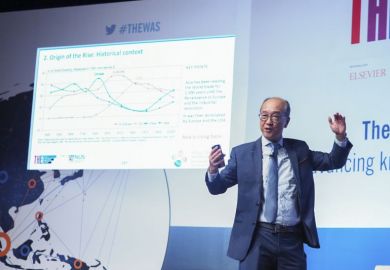China has overtaken the US to become the world’s largest producer of scientific research papers, making up almost a fifth of the total global output, according to a major report.
An incentive by the Chinese government to create 42 “world-class” universities by 2050 has led to major investment in the country’s research programmes since 2015, with a focus on science and engineering subjects in particular.
Trend analysis data have already predicted that the country will bypass the US in terms of overall citation impact within the next few years, but new figures published by the International Association of Scientific, Technical and Medical Publishers (STM) suggest that Chinese research is moving at an even faster pace than experts had anticipated.
The STM Report: An overview of scientific and scholarly publishing – an analysis of the STM publishing landscape that comes out every three years – highlights that as of 2018, there are more than 33,000 active peer-reviewed English-language journals publishing more than 3 million articles a year.
Of that total, Chinese research makes up 18.6 per cent, according to Scopus data, pushing ahead of the US (at 18 per cent) for the first time in 2016. India has also seen rapid growth in recent years, and is now producing 5 per cent of all STM global outputs, ahead of Germany, the UK and Japan – which each contribute 4 per cent.
Speaking to Times Higher Education, Michael Mabe, head of STM and co-author of the report, said that the dominance of Chinese research indicated a clear turning point in the international publishing landscape.
“The fact that China’s article output is now the largest is very significant,” he said. “It’s been predicted for a while, but there was a view this was not likely to happen until 2025.”
“Because of this rapid expansion, the total amount of R&D spend by China will exceed that of the US probably by the 2020s,” Mr Mabe predicted. Chinese R&D expenditure has already surpassed that of the whole of the European Union, reaching $409 billion (£311 billion) – 21 per cent of the global total – in 2015.
Another significant finding in this year’s report is that around one-third of all global STM papers are now available through open access, a figure the authors say is substantially lower than the overall proportion of journal titles available through open access.
But China still lags behind in this area, in part as a result of pressure from institutions to publish in top ranking international titles such as Science and Nature, which still operate closed-access publishing models.
As the international publishing market becomes more digitally focused, the shift in global dominance presents new challenges in terms of collaboration and cohesion, Mr Mabe suggested.
While academic communities in much of the economically developed world “have already embraced a much more user-focused, a much more digital environment, to the extent where almost 100 per cent of publications are now available online…a lot of domestic Chinese publishing companies haven’t entirely adopted a digital worldview”, he said.
The figures come at a time when publishers in the UK and Europe face increasing pressure to conform with open access models in light of an agreement set out by Science Europe, whereby researchers publishing papers using public funding from 11 different countries must make their work available freely and legally through open access channels.
Another trend highlighted within the STM report is the use of technology, specifically artificial intelligence, as a vehicle for productivity in publishing going forward. “The growth in the development of artificial intelligence and its implementation across industry as a whole has impacted generally on the publishing industry, partly because it can enable cost efficiencies,” the report concludes.
Register to continue
Why register?
- Registration is free and only takes a moment
- Once registered, you can read 3 articles a month
- Sign up for our newsletter
Subscribe
Or subscribe for unlimited access to:
- Unlimited access to news, views, insights & reviews
- Digital editions
- Digital access to THE’s university and college rankings analysis
Already registered or a current subscriber?








